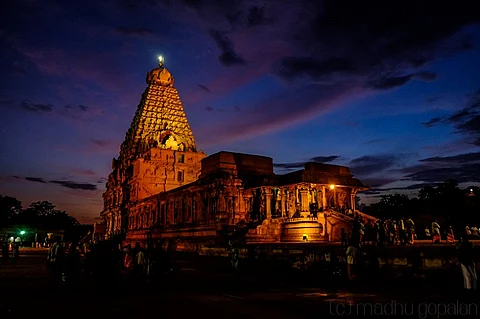

While the Pallava rulers ushered in the Dravidian style of building structural temples, it was under the Cholas that the tradition matured and evolved to its zenith. One of the greatest dynasties of ancient India, the Cholas, ruled between the 9th to 13th centuries AD. Their influence is said to have stretched up to the River Ganga in the north and all the way down to the islands of Srivijaya near present day Indonesia. The greatest of the Chola rulers, Rajaraja Chola I, ruled from 985-1012 AD. He was known for his military prowess, administrative capabilities and passion for art and literature. His capital was the fertile riverside town of Tanjore or Thanjavur, about 350km south of Chennai. It was here that he chose to build the magnum opus of Chola architecture, the Brihadeeshwara Temple, dedicated to Lord Shiva. Astoundingly, it took only about 6 years to build, and the colossal temple was consecrated by Rajaraja I himself in the year 1010 AD. It was orginally called the Peruvudaiyar Temple. Thousands of tons of granite were quarried more than 50km away and transported to Thanjavur to build it.
After the Cholas, Thanjavur successively passed into the hands of the later Pandyas, the Vijayanagara rulers, the Nayakas and the Marathas, and many of them left their mark on the Brihadeeshwara Temple. The Sivaganga fort which protects the temple, for example, was built by the Nayaka rulers, and the Marathas added a gateway in the fortification.
The entrance to the main temple complex is through two beautiful arches, with ornate gopuras on top of them, covered with stucco figures of various deities. The outer one is called the Keralantakan entrance, and commemorates Rajaraja’s victory over the Cheras of Kerala. The inner one is simply called the Rajarajan entrance, and is flanked by two huge and fierce dwarapalas or guardian deities, a feature typical of Chola architecture.
Inside, the temple's enormous pyramidal vimana, nearly 60m tall, soars spectacularly into the sky, representing the sacred mountain Meru. Inscriptions in the temple refer to it as Dakshina Meru, or the Meru of the south. Built in solid granite, it narrows tier by tier to a bulbous shikhara at the top. A rare feature in this temple is that the vimana is much taller than the entrance gopuras. It is usually the other way round in this region.
The vimana is hollow inside, all the way to the top. At its base, the sacred garbhagriha houses an enormous monolithic Shivalinga, called Brihadeeshwara, the main deity of this temple. He is also called Rajarajeshwara, which means, the Lord worshipped by Rajaraja. Two walls surround the garbhagriha, forming two passages running all around it. Chola frescos covered the walls of the inner passage, but they were painted over in the Nayaka era. The ASI used a process called de-stucco, to chemically peel the top layer off, preserving both sets of paintings. The Nayaka paintings are now on display, mounted on fiberglass boards. An incomplete series of sculptures decorates the walls of the outer passage, depicting Lord Shiva in 81 of the 108 karanas, or dance movements in Bharatanatyam.
A shrine dedicated to Chandikeshwara, a saint worshipped along with Lord Shiva, stands close to the main vimana. The practice of building separate shrines for attendant deities besides the main one, began under the Cholas. There are more shrines dotting the complex, added by the Nayakas and Marathas. A huge monolithic nandi or bull, the second largest of its kind, stands in a pavilion facing the vimana - it was added in the 16th century.
The Brihadeeshwara Temple was the first of the Chola temples to be inscribed on UNESCO’s list of World Heritage Sites. A masterclass in architecture, engineering, logistics, planning, execution and record-keeping, the temple truly reflects an empire at its peak and bears testimony to a civilization with extraordinary knowledge, ability and sophistication.
This is a part of our photo-series on the UNESCO World Heritage Sites in Tamil Nadu. You can view the rest of the series here.
Update: The original name of the temple has been added following reader feedback.